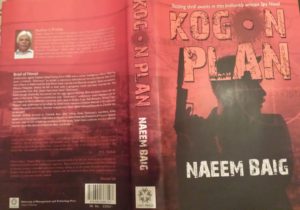
(Reviewer: Sultan Mahmood Niazi)
Book Name: Kogon Plan (Novel, Thriller)
Novelist: Naeem Baig
Publishing Data: UMT Press, Lahore (Year, 2014)
The intrigue goes on building up at whirl-wind speed; the intensity of the plot is rapidly escalated; the background to the events is artistically painted in miniature detail and the story is narrated in lucid yet artistic language – it all happens in Naeem Baig’s second novel, KOGON PLAN.

The author acknowledges the influence of Ibne Safi as the source of his inspiration, but Kogon Plan transcends the scope of Ibne Safi’s novels in almost all aspects of artistry. The canvas of Naeem Baig’s novel is more broadly spread beyond the regional boundaries, and his narration far surpasses the skill of the acknowledged mentor as a raconteur. While Ibne Safi mostly depended on the humorous component in the build-up of his stories, Baig maintains an air of profound serenity throughout. Countering of the subversive plots against the national integrity is no joking affair. It needs intense concentration, deep mental probing and physical and mental agility to break the crypt intricacy of the schemes of the enemies. Mohammad Hanif is another Pakistani writer exposing intrigue and betrayal in his ‘The Case of the Exploding Mangoes’, but he restricts the action in his novels within the territorial boundaries of the country. Naeem Baig’s Kogon Plan is neither constricted in space nor characters to any such limits.
Even a casual exploratory voyage through the very first chapter convinces the readers that they are in for a hefty and multifaceted entertainment full of action and thrill. It immediately ignites the reader’s curiosity to explore further. The events narrated in the novel can easily be contextualised, resulting in the suspension of disbelief, in the light of the existing situation on the western borders of the country. That is one of the major attractions in a work of fiction. Action may be taking place on the streets of Kabul in Afghanistan, or at the fishing harbor in Sri Lanka, or in the remote recesses of the African continent, the reader feels that it could be happening so in reality. Such events take place every day in the region, hence, there is ready acceptance of what is presented by the novelist.
Scene description is one of the main features of Naeem Baig’s art as a novelist. He has had the advantage of being personally familiar with most of the foreign places where the action in the novel occurs. His intimate description of places in Kabul, Dubai, Colombo and Zanzibar is the outcome of his visits to those places. The rest of the places were extensively researched by him on the Internet before they were described and discussed in the novel. The outcome is that there is not the slightest vestige of being unrealistic in respect of the geographic details painted by him so intimately with the precision of a miniature artist.
Besides that he has the artistic facility of creating images at will. The cumulative effect of personal experiences and research outcomes is that whatever places and scenes are described by the writer bear the stamp of authenticity. He looks at the environment with the eyes of a poet and eloquently transcribes the landscapes on his canvas. His description of Islamabad at the start of the second chapter is a photographic representation of the capital.
A city master-planned by a Greek architect and designer in the late fifties with its face towards the Margalla Hills on the north-eastern fringe of the Potohar plateau, with plenty of rains and lush green landscapes covered by rows of flame trees, jacarandas and hibiscus. Roses, jasmines and beaugainvillas fill the parks and scenic view-points which symbolize the aspirations of this young and dynamic nation. It is an ideal city to culminate careers in the government.
All the protagonists of action in the novel are everyday human beings, commonly found moving around us. They are not super human beings in any way, though all of them are recognised by their peculiar traits but they don’t behave or perform like aliens. Their only distinctive feature is their determination to produce results and their indomitable perseverance in their individual pursuits. No one seems to be willing to relent. Their idiosyncrasies keep on goading them to pursue their goals to the final end.
Sahel Farhaj, aka Sher Ali’s, character is delineated through the analysis of his traits of stubborn struggle in spite of the opposition on the part of his immediate boss, who, in turn follows the advice of his impulses. Razmak Bilal, Sahil’s antagonist, displays similar characteristics of unflinching rigidity of purpose in his subversive designs. He goes on killing innocent people without remorse because he thinks he is justified in doing so on account of the abuses hurled on him because of his father’s betrayal of the national honour at the hands of the Russian communist forces. At the same time he pledges his services to the same party which is alleged to have purchased the loyalty of his father.
A detective thriller would be drab if it does not contain enormous amount of the element of suspense it. The novel opens with various members of NSB’s Special Operations group vigilantly poised to perform whatever functions were assigned to them on the streets of Kabul. Everyone is on toes in order to ensure that the mission is successfully accomplished and Razmak Bilal, the target, is captured. The target is equally good in watching his surroundings and takes extreme pre-cautionary steps to foil any possible attempt at shadowing him. When the final moment of nabbing him arrives and the readers start feeling relaxed, the twist in the story occurs.
“They mounted the side-walk and closed in on Razmak’s back. They coked the slides. It was then that Razmak turned and Ali was expected to see the snout of the Makarov pistol that he knew Razmak carried. But instead, what faced him was an expression of initial greeting that quickly turned to surprised horror and would haunt Sher Ali for the rest of his unnatural life. As he reached closer to the target to grab his both wrists at one stretch, a burst of .45 magnum automatics suddenly sprayed on the chest and belly of the target blowing him off in the air backwards. Ali knelt down and shouted over to Baba to get back in the car. A semi-automatic medium range fire.
A shot sounded, the shell dropped in front of him after hitting the wall. Another rubbed his left shoulder. Ali squeezed in for a moment, turned his face left and then three rounds from the Colt came. Taking shelter behind the corolla over to the window on his left, he glanced at the window on the left side building where he could see the mild smoke of gunfire. He quickly got up and emptied his pistol at the invisible shooters and jumped into the car. No sign of shooters in the window. They might, by now, have left the window.”
Sahel’s mission in Kabul ended in a fiasco. The Russians had used a party of Uzbeks to deny him the moment of triumph. He was also grievously wounded in the leg. Symbolically speaking they had not only managed to take the feet from under him, they had achieved another sinister purpose. Later on it is revealed that the slain person was not Razmak, but his look-alike brother, Gulo, used as a bait to draw out the special operations group of the NSB. Gulo’s death served the purpose of turning Razmak into a sworn enemy of the group. As a result of highly sophisticated plastic surgery, his visage was completely altered into the face of a young, highly civilized Pakistani bureaucrat posted in the president’s secretariat. The Russians had succeeded in turning a young man squirming under the eyes of the patriotic Afghans into a blood-thirsty monster.
The way Sahel is whisked away out of Kabul in the garb of a cancer patient on the point of death is a treat to read. Naeem Baig deserves a pat on the back for inventing the marvelous stratagem for Sahel’s evacuation to safety. A lengthy process of surgery, recoupment and recovery follows. Ordinarily such a phase of rehabilitation should have been a sedate affair, but it goes to the writer’s credit that he continuously maintains the thrill through Col. A.K. Zawri’s hostile handling of the post-operational process. In spite of having a handicapped knee, Sahel is put through a grueling course in martial arts. His resilience and determination keep on motivating him to not to yield.
The members of the Special Operations Group of NSB started being fatally targeted at intervals. The tactics applied by the murderers smacked of Razmak’s modus operandi, but Sahel’s superior boss was not willing to accept that the monster could be re-incarnated after his death. One of Razmak’s operatives finally spills out the beans. Sahel follows Razmak to Zanzibar but finds another member of the group eliminated. In Sri Lanka, Sahel is nabbed by the security personnel, while Razmak mischievously gloats over the spectacle as an amused by-stander. The novelist realizes the comparatively weaker position of his hero as compared to that of the villain. Razmak is physically much stronger and mentally far sharper and more cunning than Sahel. As the two of them come face to face in the end, Razmak savours his advantages and puts him in the awkward position of one who has to obey the mightier. Only Sahel’s determination keeps him from total submission. Charged with the spirit of desperation he takes the self-effacing step.
Sahel was frozen in his half bow, his mouth suddenly dry as sand, his breath like waves of sea, and the pulse pounding in his throat. He stared at the shadowed face, immobile, his eyes blazing like a furnace. Sahel moved slowly up. His eyes on Razmak’s face, he lowered his pistol towards the roof, wanting to try it anyway, knowing that he would be blown off the lower roof into Dilshad’s lap if hand even trembled.
He straightened up now without the weapon turning a bit, facing full to the front, his limbs shivering cursing with blood. From somewhere far below, he heard the band playing its favorite tune. He visualised the arrival of the president on the stage. They would never make it. He heard another sound, the drone of a distant voice. Slightly metallic, the speech echoing in the great show.
Unbelievingly, he felt his body moving forward, rebelling against a mind that tried to compel him to stop. Yet Razmak watched him quietly.
“Do not worry, Capt. Sahel Farhaj,” the voice said in perfectly controlled Urdu. “You will only have to witness the assassination of your president. And I will end it for you, as you ended it for my brother. Now drop your gun on the floor.”
Sahel had no way except to comply with the orders. He lowered his hand and set his pistol slowly on the floor.
The automatic gun began to move slowly, its line changing just slightly. He was going to shoot Sahel, not kill him yet, just enough to immobilize him. While then he would step to the stand and use the RPG, blowing them all back into a terrible pledge of tribal revenge. He was going to shoot Sahel in the legs.
“You killed Gulo!” Sahel was amazed that he could find his own voice, harsh and horse as it was with terror. “You killed your own brother.” He moved his foot forward almost dragging it. “You used him like a tethered goat and I was merely an instrument to bring you to the law and you knew it very well, Mr. Hayat Gul.”
He hit the mark. Razmak lifted his head, his eyes narrowing and rage crawling over his face. For that crucial millisecond, he raised the gun to fire at Sahel’s chest, and Sahel made the only move he could, the only technique he had ever managed to do half-well in Krav-Magza.
He lunged his left foot, snapped his right hand forward up over catching the gun and side-stepping as it exploded next to his face, He yelled as he struck out with his right fist, but Razmak snapped his head away and the punch went wild. He felt a sharp blow to his knee, but still he held on to the gun, yet in a split second he knew that he would never complete the move, could never turn the weapon on Razmak and use it. An open hand copped down into his face as he twisted to the left with all his might, swinging his right hand over towards the automatic, slamming into it, wrenching it from Razmak’s grip as he followed through and hurled it high and away into the air.
For the friction of a second pause, they stood empty-handed, eyes into eyes. But it was no match. Sahel did the unthinkable.
As Razmak’s eyes blinked in disbelief, Sahel yelled out Amber’s name, launched himself forward in the air and gripped his arch-enemy in a bear-hug of hatred that took them both over the edge of the parapet to the full length of a long hollow scream seventeen storeys down on to the Scion Hotel fore-court far below.
Naeem Baig has a peculiar ease of words, both for cogently describing the scenes and for eloquently narrating the actions and incidents. Such natural linguistic flow is only the result of extensive reading and long scribbling practice. Baig doesn’t have to choose his words; rather the words stream down his mind in a natural flow and arrange themselves properly into masterly patterns. It is a very rare quality among the Pakistani writers in the English language that they can refrain from employing the verbose or over-indulgence in florid rendering of the matter in hand. Naeem Baig is one such artist.
It would make an interesting study to compare ‘The Kogon Plan’ with ‘The Case of the Exploding Mangoes’ by Mohammad Hanif. We are likely to realize that both the writers display equal facility of recounting the stories, but there is greater variety in painting the scenes and greater scope of presenting the happenings in the case of Naeem Baig. He has an ever vigilant eye on the interest of the nation. He does not express sarcasm or revulsion for those who wield political powers. Even Col. Zawri is ultimately shown to have regard and affection for the team members and his apparent rudeness is merely a camouflage to hide his real feelings.
Both of them seem to have so close association with the defence organisations of Pakistan that they do not find any hesitance in talking as inside men, but surprisingly the writer of The Kogon Plan happens to be a senior banker having nothing to do with the armed forces. In the selection of words too, Naeem Baig is quite sophisticated. He avoids lapsing into vulgarity and sensuality for the sake adding spice to the matter. He continues to present the subject matter in simple terms and ends up creating a master-piece. Despite frequent editing lapses, the end-result is simply marvelous. Well done, Naeem Baig! Hope the second edition of the book is entirely freed of all typographical mistakes and editing omissions. The readers would be eagerly looking forward to the arrival of the next edition.
……………………………………….
About the Reviewer
(The reviewer, Prof. Sultan Mahmood Niazi, has been a college and university teacher of long standing experience, an eminent textbook writer, founder M.D of Balochistan Education Foundation, former Chairman, Balochistan Textbook Board, former Head of English Department and Director (communications), BUITEMS, Quetta)

